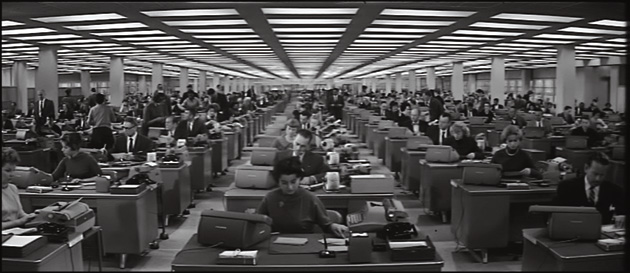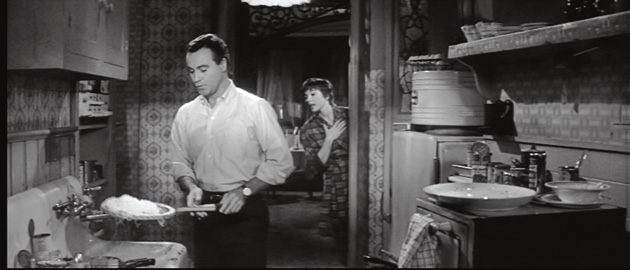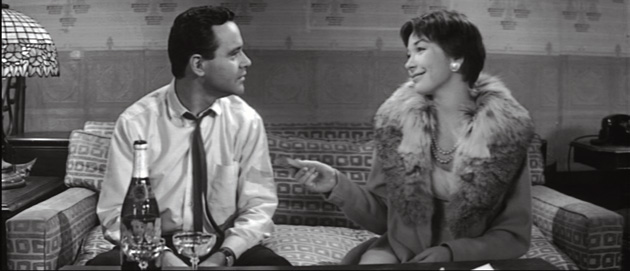BY AMY DAWES
 ROLE MODEL: Nancy Meyers used Billy
ROLE MODEL: Nancy Meyers used Billy
Wilder's The Apartment as a "guiding light"
for her romantic comedy The Holiday.
No matter that she's seen it at least a dozen times, Nancy Meyers settles in with great eagerness to watch
The Apartment, Billy Wilder's 1960 best picture Oscar winner, at her office in an outsized bungalow on the Columbia lot. "I watched this twice while I was writing
The Holiday," she says of her recent romantic comedy. "And once while I was making it."
Meyers notes: "This was kind of a guiding light, because I had a similar relationship in my movie. With the Kate Winslet and Jack Black characters in The Holiday, I was writing about two people who had been hurt by love, and whose friendship blossomed into a romance, so I sort of tracked the way it was done in The Apartment." The movie has been such a touchstone, she says, that she's kept a paperback copy of the script beside her writing desk for some 20 years.
Wilder's movie, shot in black and white CinemaScope, stars Jack Lemmon as an accountant at a huge Manhattan insurance firm who advances by letting higher-ups at his company use his apartment for extramarital trysts. He's sweet on an elevator operator played by Shirley MacLaine, but soon discovers that his own apartment is being used by his married boss to conduct an affair with her.
Given its frank and scathing view of sexual relations, I suggest to Meyers that perhaps the biting comedy-drama is anti-romantic, but she will have none of it. "His feelings for her seem very romantic to me," she says. Adolph Deutsch's score swells over the titles and the opening image of a warmly lit brownstone on a dark New York street, and she notes, "This is your first clue. Sweeping romantic music. The director chooses everything, and he could have said, 'This isn't right for my movie,' but sweeping romantic music is how it starts."
Then as brisk marching music and a helicopter shot of Manhattan accompany Lemmon's voice-over, she says: "Now he's telling us, 'comedy.' That's how I read it. Music is like added dialog to your movie: it's information, and it puts you in a mood."
 RAT RACE: Wilder created forced perspective with gradually smaller desks and a matte
RAT RACE: Wilder created forced perspective with gradually smaller desks and a matte
painting in the background to show the vast insurance firm where Lemmon works.
In the vast, Kafkaesque office set by Alex Trauner we get our first view of Lemmon as a desk worker in a sea of countless others just like him. Meyers greets the shot with enthusiasm: "This is famous. It's called forced perspective; it was done with a matte painting at the end; and with tinier desks going back, so it has this look of going on forever and eight gazillion people working there." Indeed, in the pre-CGI era, Trauner reportedly used dwarves at the rear desks, and then cutouts to make the room seem to stretch even further.
Meyers keys in with great pleasure on the details of Lemmon's performance. As C.C. Baxter, he types figures into an adding machine, and, with a sliver of sardonic attitude, bobs his head as the machine rhythmically tallies results. "This is great, how his head goes in time with the machine, and it's in time with the music," Meyers enthuses. "There's nothing superfluous in a Billy Wilder movie. Every shot is about telling you a story. Like now, the clock ticks, it's 5:20, cut to everyone's putting the covers on their typewriters and getting the hell out of there."
Out on the street, the camera pans Baxter's apartment window as music and laughter float down from it. In a hat and rumpled overcoat, Baxter stands forlornly on the street beneath it. "I have this little problem with The Apartment," he confesses, introducing the central premise of the movie. "I can't always get in." Meyers quotes the line right along with Lemmon, and notes, "This is where the voice-over ends. I love that there's no narration anywhere else in the movie. In Baby Boom," she points out, referring to her Diane Keaton comedy, "We did it the same way. I said, 'if Wilder can do it, I can too.' You always think there are these rules, but there aren't, and if there are, these are the people who created them."
Inside Baxter's apartment, an executive named Kirkeby and his voluptuous paramour have finished their tumble and are preparing to vacate. Though it appears natural, Meyers points out that both actors are facing the camera, the man in the foreground, as they collect their belongings and bicker. "It's always hard to get two people facing the camera at the same time, but here, you feel his back is to her because he's done with her. It adds meaning," she says. "Wilder does this so brilliantly; there's never anything awkward about his staging."
In a wide exterior shot, the couple exits the brownstone via its raised steps, while Baxter, visible in the same shot, huddles miserably against the stairs awaiting access to his own apartment.
"Everything is so beautifully choreographed; I never want to be anywhere but where he puts me," says Meyers of the framing. "But could you do that today? Would an audience accept so many wide shots? This movie was shot in about 30 days, and edited in a week, so you know, it can be done. But you better have genius actors if you're going to shoot this many wide shots."
As for Lemmon, Wilder had just featured him in Some Like It Hot, and was wild about him. "He's a master screen actor. When someone's so physically funny, you do want to be wide. I know that from shooting Diane Keaton, because she delivers a line with her whole body, and you don't want to be in close, or you'll miss that."
 AL DENTE: Lemmon gets goofy with a woman in his apartment and strains spaghetti with a tennis racket.
AL DENTE: Lemmon gets goofy with a woman in his apartment and strains spaghetti with a tennis racket.
Inside the apartment, we see Baxter moving busily about as he cleans up after his erstwhile guests, at one point finishing up the snacks they've left on a plate. "This is where I fall in love with the movie," enthuses Meyers. "He's eating their leftovers."
But soon Baxter's domestic rights are usurped once again-yet another company higher-up calls and demands instant access for a romp with a Marilyn-esque floozy. Baxter pulls pants on right over his pajamas, and is back out on a rainy street. The temperature that night in New York had plunged to 16 degrees, so Lemmon was actually underplaying his pathos, but Meyers points out that the sympathy of his performance was key to warming up Wilder's harsh worldview. "I love that his pants are so short that his pajamas stick out underneath them. It's like a clown outfit," she says. "It's a great feat to make this character so loveable, given that he's running this whatever-it-is. It would have been a very different movie with somebody else."
The sequence ends with Baxter huddled foreground on a very long, wet park bench that becomes just a white streak as it stretches into the opposite reaches of the dark frame. "This is such a beautiful shot, because you see that he has no one," Meyers observes wistfully.
The next sequence starts with happy marching music and a flood of overcoats crossing a Wall Street lobby. We meet Baxter's would-be someone: Fran Kubelik (MacLaine), the spunky elevator operator, whose new short haircut Baxter is quick to compliment. Meanwhile, he's mopping his nose with a Kleenex. "This is probably the first romantic-comedy cold," observes Meyers. "Followed by 8000 movies that have given the romantic comedy lead a cold."
"You've got a lulu," observes the pixie-faced Kubelik to Baxter, while Meyers keys in on the framing: "Here's the first tight two-shot in the movie, and he keeps them in the same frame, so you begin to feel they belong together."
Soon Baxter is summoned to an upper floor for a masterful scene involving Fred MacMurray as Jeff Sheldrake, a top executive who pretends to be appalled over word of the love nest Baxter is running, then asks for the key himself.
At a Chinese restaurant where the married Sheldrake tries to rekindle his relationship with Kubelik, whose heart he's broken before, the angle emphasizes the table wedged between the lovers. "Do you see the difference, compared to the way the scenes are shot with Lemmon?" asks Meyers. "In those, they're full of life, bopping up and down. But this is all static, they're not going anywhere. It feels awkward and hard."
Meyers also points out Wilder's clever use of props in a couple of key scenes that involve a cracked compact mirror belonging to Kubelik. Lemmon's face is seen in it at the instant it dawns on him that the girl he loves is the same one involved with his reprehensible boss, and a beam of light flashes briefly from the mirror to his forehead to underscore the realization.
"This is the great reveal, and it all just plays off his expression," notes Meyers as the clever shot unspools. "From here, there's a big tone change in the movie, to something darker and more real. It's so smooth, you're so with it, and that's such a hard thing to do."
The big promotion that Lemmon's character has just gotten only twists the knife. It's Christmas Eve, and he heads for a bar to drink away the pain, knowing that the two lovers are using his apartment.
But the date goes badly, and when Kubelik is left sobbing and suicidal, she puts on a record of the movie's theme music, already played by a piano player in the Chinese restaurant, to provoke even more grief. "How does Wilder know this about women? She's put the music on so she can get it all out. She just sobs. It's so real," marvels Meyers.
Next comes a masterful shot as, back home, Baxter opens the bedroom door to fling a pair of gloves into the darkness and finds Fran unconscious on the bed, a light shaft illuminating her comely legs. The perspective is from across her body; Baxter's reaction is seen only after he slams the door. He reopens it, then races to get the doctor who lives next door and they vigorously work to revive his unexpected guest.
 A bottle of champagne at the end suggests the promise of romance, but the happy ending is earned.
A bottle of champagne at the end suggests the promise of romance, but the happy ending is earned.
Later, he's more than happy to nurse Kubelik back to health, lit up as he always is in her presence. "This scene is a classic," says Meyers as Baxter hums around the kitchen, using a tennis racket to strain spaghetti. "Here he's got a girl alone in his apartment, and he's just getting goofy. He doesn't have sex appeal, so it's a challenge, I think."
"It's a wonderful thing, dinner for two," the lonely bachelor says to Kubelik. "That's one of my favorite lines," Meyers remarks. "It just tells you so much about his life."
The story gets a shot of energy from a new direction when Fran's brother-in-law, a hard-nosed cabdriver, finds her at Baxter's apartment and getting the wrong idea, punches him out. Baxter's delighted when Fran fusses over him. "You still don't think the movie's romantic?" Meyers presses earnestly. "He takes that punch for her, and it's worth it because she comes to his rescue."
As the story progresses to New Year's Eve, Fran is still under Sheldrake's sway, but comes to her senses in a scene at the noisy, festive Chinese restaurant, where each of them wears a party-hat crown. "I love how his hat makes him look stupid, and hers makes her look royal. They've completely switched positions from the first time we saw them in this restaurant. He's been directed to act dumber, and she finally sees him for what he is," observes Meyers.
As "Auld Lang Syne" breaks out, Kubelik leaves the restaurant and runs through the streets to Baxter's apartment.
"This is the first movie in which I saw the girl running to be with the guy at the end, instead of the opposite," says Meyers, "I used that at the end of The Holiday, where I have Cameron Diaz running back to be with Jude Law, because she finally gets it."
Now, she reveals a surprise occurrence that helped enhance her sense of connection to the movie she's admired for so many years.
"When I was writing my ending, I thought, I wonder how Billy Wilder described the look on Shirley MacLaine's face in that scene." So she picked up the script she has always kept nearby.
"He wrote, 'She runs to him with a happy, expectant look on her face.' So I wrote that, just for a little private moment. And I finished my script. 'The End.'
"That night I was invited to a friend of mine's house for a party, and I got there, and Shirley MacLaine was there," she laughs. "It was spooky. I'd never seen her before in my life. Of course, I couldn't help but tell her what I'd done that afternoon in my script. And she said, 'Well, let me give you a hint. Make sure you have a fan on whoever plays the girl, because he had a fan on me, and it really helped with the run.'"
We stop the movie, seconds before it will conclude, to replay this scene of emotional catharsis, and indeed, as MacLaine runs with her head tilted back, a subtle breeze ruffles her hair and fur collar, enhancing the effect of her radiant expression.
Fran arrives at Baxter's apartment to the sound of a gunshot. In a classic Wilder touch, playing dark against light, it turns out to be only a champagne cork popping. The two lovers settle back to enjoy a game of gin and each other's company. Lemmon gushes, "I love you, Miss Kubelik. I absolutely adore you," and MacLaine replies tartly, "Shut up and deal."
"She doesn't say 'I love you' back. I like that," Meyers muses. "It's the promise of a romance, and the idea that she could accept a good guy over a heel." As the romantic score swells to take us out of the movie, Meyers nods her head with great satisfaction, and observes, "Happy ending, man. I love it. They earned it."
Meyers says she saw MacLaine again recently during an onstage Q&A when The Apartment was screened on opening night of the new Billy Wilder Theater in Westwood. She was intrigued to hear her say that she and Lemmon were never given a full script during filming. "Wilder must have wanted to keep them in the moment, and keep it real," Meyers speculates.
She met Wilder himself once in 1984. The late film master signed a poster of his Love in the Afternoon with the message, 'Keep Going.' It's framed in her office. "I didn't know what he meant then, but I do now," she remarks as she shows me out. "There's always so much to learn. As many times as I've seen this movie, I've never really seen it like I have today."